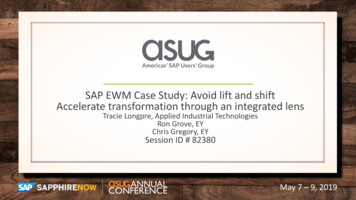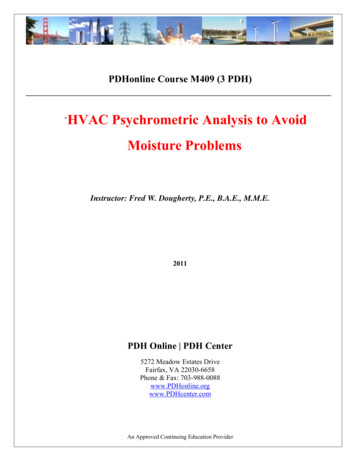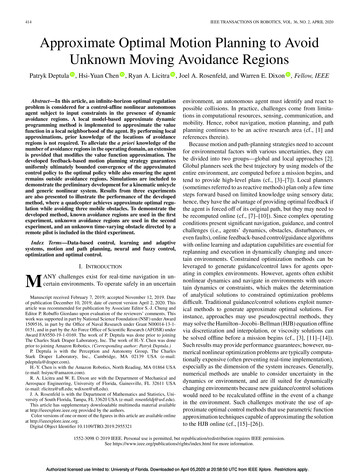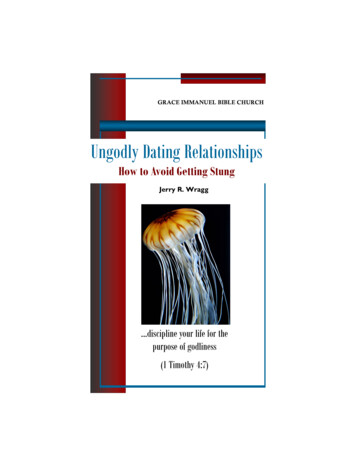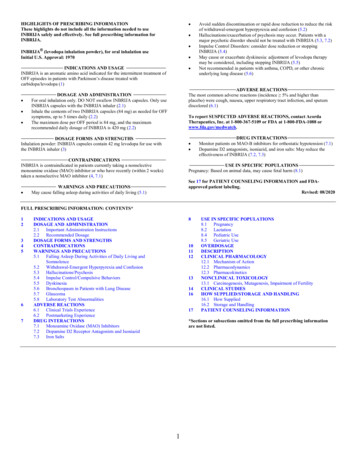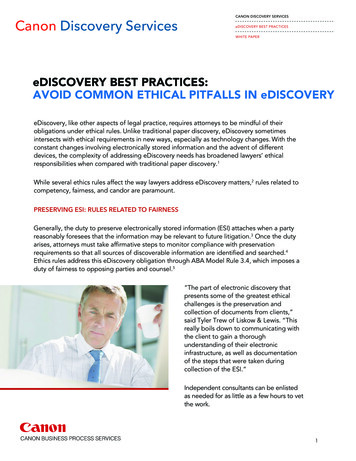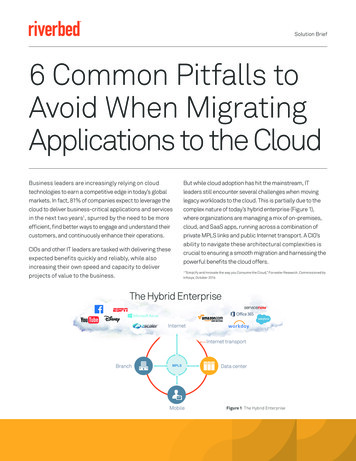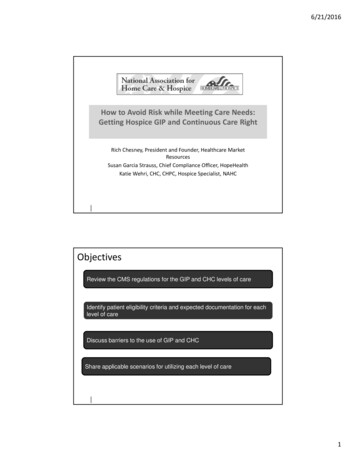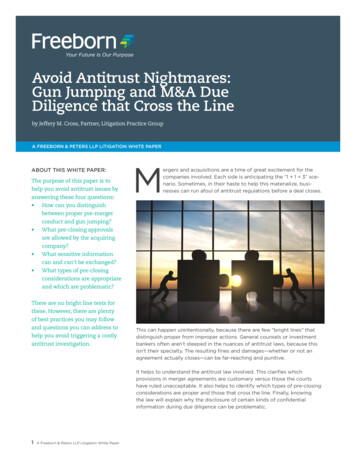
Transcription
Avoid Antitrust Nightmares:Gun Jumping and M&A DueDiligence that Cross the Lineby Jeffery M. Cross, Partner, Litigation Practice GroupA FREEBORN & PETERS LLP LITIGATION WHITE PAPERABOUT THIS WHITE PAPER:The purpose of this paper is tohelp you avoid antitrust issues byanswering these four questions: Mergers and acquisitions are a time of great excitement for thecompanies involved. Each side is anticipating the “1 1 3” scenario. Sometimes, in their haste to help this materialize, businesses can run afoul of antitrust regulations before a deal closes.How can you distinguishbetween proper pre-mergerconduct and gun jumping? What pre-closing approvalsare allowed by the acquiringcompany? What sensitive informationcan and can’t be exchanged? What types of pre-closingconsiderations are appropriateand which are problematic?There are no bright line tests forthese. However, there are plentyof best practices you may followand questions you can address tohelp you avoid triggering a costlyantitrust investigation.This can happen unintentionally, because there are few “bright lines” thatdistinguish proper from improper actions. General counsels or investmentbankers often aren’t steeped in the nuances of antitrust laws, because thisisn’t their specialty. The resulting fines and damages—whether or not anagreement actually closes—can be far-reaching and punitive.It helps to understand the antitrust law involved. This clarifies whichprovisions in merger agreements are customary versus those the courtshave ruled unacceptable. It also helps to identify which types of pre-closingconsiderations are proper and those that cross the line. Finally, knowingthe law will explain why the disclosure of certain kinds of confidentialinformation during due diligence can be problematic.1A Freeborn & Peters LLP Litigation White Paper
Gun Jumping and theActs that Determine ItA Platinum ExampleSometimes a tale of what not to do can be the best teacher. That’s the casewith the 1999 Computer Associates (CA) acquisition of Platinum Technology.CA developed, marketed and supported software products—includingsystems management software—for a variety of computers and operatingsystems. Platinum sold mainframe systems management software products.The companies competed in a number of areas.In March 1999, CA and Platinum announced a merger agreement and fileda Hart-Scott-Rodino (HSR) notification. The Department of Justice (DOJ)opened an investigation and ultimately found the proposed merger wouldeliminate competition in five markets. In May, the DOJ filed a complaintattacking the merger and filed a proposed final judgment requiring thecombined company sell some of its assets.Gun jumping is improper coordinationbetween firms before they merge.Determining if these situations haveoccurred comes under the purview ofthe Department of Justice (DOJ) andthe Federal Trade Commission (FTC).Clayton Act, Section 7A is commonlyknown as the Hart-Scott-RodinoAntitrust Improvements Act (HSR).Thisrequires that companies 1) provide adetailed filing to the DOJ and FTC, and2) wait for those agencies to determineif the merger will adversely affect U.S.commerce under antitrust rules. Ifcompanies take actions that indicatethey transferred beneficial ownershipbefore the waiting period ends, theyhave violated the Act. The fine forviolating HSR is 16,000 a day.Sherman Act, Section 1 deals withcompanies that serve overlappingmarkets. If these firms’ actions resultin an unreasonable restraint of tradebefore a merger closes—when they arestill technically competitors—they haveviolated this Act. The Act applies evenif the transaction does not have to bereported under HSR. And the Act maycontinue to apply if 1) an agency hascompleted its HSR analysis and endedits investigation, or 2) the merger isblocked.2A Freeborn & Peters LLP Litigation White PaperIn September 2001, the DOJ filed suit against CA and Platinum for gunjumping, alleging they had violated the Sherman and Clayton Acts. The finaljudgment from the District Court fined CA and Platinum 638,000 in civilpenalties. It also prohibited CA from certain conduct with future mergerpartners for 10 years. In addition, the DOJ was allowed to inspect recordsand interview employees during those 10 years. CA also was required toestablish a compliance program.Here’s what the companies did—and didn’t do—that led to this adverseruling.Customary TermsThe merger agreement contained common merger provisions that requiredPlatinum to run its business as it ordinarily would. This meant that Platinumcouldn’t do any of the following without CA’s approval: Declare or pay dividends or stock distributionsIssue, sell, pledge or encumber its securitiesAmend its organizational documentsAgree to acquire other businessesMortgage or encumber its intellectual property or other material assetsoutside of the ordinary course of businessMake large new capital expendituresMake material tax elections or compromise tax liabilitiesPay, discharge or satisfy any unusual claims or liabilitiesStart lawsuits other than routine collection of billsThe District Court noted that these provisions limited Platinum’s ability tomake business decisions without CA’s consent. However, the court ruledthat these were standard requests. They reflected the underlying goal toprevent Platinum from doing anything that seriously impaired the company’svalue before the acquisition. As a result, these provisions didn’t violate theantitrust laws.
Gun JumpingOn the other hand, the court found stipulations in the merger agreementthat 1) created a situation where these two competitors were colluding, and2) imposed extraordinary conduct-of-business limitations on Platinum. Thisenabled CA to control Platinum’s operations and affect an improper transferof beneficial control before the deal closed and also before the mandatorywaiting period under HSR. For example, the agreement stated Platinumcouldn’t take any of these actions without CA’s approval: Enter into any agreement to provide services for more than 30 days at afixed or capped priceEnter into customer sale or license agreements with non-standard termsEnter into a sale or license agreement offering discounts of more than20 percentIn addition, the merger agreement changed Platinum’s ordinary proceduresfor approving customer contracts. The court noted that the agreementto limit Platinum’s right to independently set its prices was extraordinaryand not reasonably related to any legitimate goal of the transaction. Theseactions were unlawful and qualified as gun jumping.Exchanging Sensitive InformationThe court also found two restraints that further compounded the issue.CA entered into consulting and non-compete agreements with Platinum’sCEO, COO and CFO—making them personally liable if the company failedto comply. And, Platinum’s sales representatives were told there could beno fixed price contracts without CA’s approval—even for sales agreementsunder the 30-day limit. These provisions resulted in the following actions: A database was created that tracked the pre-approval processThis database contained competitively sensitive dataCA had access to the database—and no limits were placed on who atCA could see this informationCA was able to change Platinum’s method of booking revenue andreverse previously recognized revenues for customer contractsCA cancelled Platinum’s participation in a trade show, where thecompany would have presented products and sought future businessThe final judgment on the CA case also has some general implications onpre-closing coordination. These are worth noting for other M&A situations.It stated that the acquirer couldn’t enter into an agreement that establishesany price or discount of the other party. And, neither party can grant theright to negotiate, approve or reject any bid or customer contract for theother operation.In addition, neither company can be required to provide the other with bidinformation. However, if the companies are competitors, either one may getbid information during the due diligence process as part of understandingthe future earnings and prospects for the potential partner. But this is onlyavailable under a non-disclosure agreement. As a result, no employees whoare directly involved in marketing, pricing or selling a product or service willbe able to see this information before a merger closes.3A Freeborn & Peters LLP Litigation White Paper
Useful Questions from the FTCIn public presentations, Federal Trade Commission officials have identified a numberof questions the organization uses when reviewing situations for gun jumping andexchanging sensitive information: Is the information shared and the transition planning done necessary for the merger’s success?What planning is best postponed until after the merger closes?Has access to confidential information been limited to the deal team?Has the buyer isolated the seller’s marketing and sales information from its personnel in charge of these functions—andvice versa?Has the sales and marketing information given to the planning team been historical and aggregated? Were any capital spending decisions stopped or postponed until after the merger and under what circumstances?Who made the decision not to proceed with a project or retain certain key people?To what degree will the seller’s competitiveness be harmed if the deal does not close?How would the overall level of competitiveness in the market be harmed by the merger?To what extent would the merger represent a material change in the seller’s operations?Was there any coordination on prices to customers before the deal closed?Did the allocation of accounts (such as revenues) change during the interim period?Did the companies distinguish between joint marketing of competing products and joint marketing of the transaction?Did the buyer redirect any of the seller’s advertising or dictate the context of the seller’s ads for competing products?Overarching Tests from the Sherman and HSR ActsGun jumping becomes more of a concern when the merging companies arehorizontal competitors. From an antitrust perspective, the issue is collusion—without any reasonable justifications that this will improve competition inthe market. When considering a business combination, it’s useful to answerthe overarching questions raised by both acts.The Sherman Act is concerned with coordination and exchange of databefore the deal closes. It focuses on information that may have an anticompetitive effect without plausible pro-competitive justifications. DOJor Federal Trade Commission (FTC) investigations under this Act aim todetermine if the data shared was necessary for an effective merger, or ifit facilitates collusion. The Act also focuses on the idea that informationmust be shared in the least anti-competitive manner. In examining how thishappens, the Act looks for the balance between potential adverse effectsversus the justifications. It also takes into account whether there werealternative ways to accomplish these objectives.The overarching test under the HSR Act deals with ensuring merging firmsdon’t effectively transfer beneficial ownership until the waiting period isover. Its examination rests on how much pre-merger coordination andplanning amounts to an effective transfer of beneficial ownership before theend of the prescribed waiting period under the Act.4A Freeborn & Peters LLP Litigation White Paper
The FTC on SuccessfulM&AsWhat This Means for Your MergerHere’s the bad news. The CA and Platinum case—along with many others—aswell as the two Acts don’t really give us specific lines not to cross. However,we’re still able to draw a number of conclusions and recommendations.Use Provisions that Protect the Seller and BuyerThe provisions in the agreement must clearly allow the company beingacquired to do business in substantially the same way it did before themerger.Successful mergers require more thanprovisions to protect value or permitdue diligence. Pre-consummationplanning is clearly required. Thegovernment antitrust enforcementagencies recognize this. A 2003 FTCsurvey1 identified these five points tofactor into this process: “Early planning for the integrationof the new physical and humanassets improves the chances ofsuccess.” “Fast-paced integration and earlypursuit of available cost-savingsimproves outcomes.” “Managers must be cognizantof cultural differences betweenorganizations and avoid conflicts,in part, via frequent, tailoredcommunication with employees,customers and stakeholders.” “Particularly in mergers involvingtechnology and human capital,managers must retain the talentthat resides in the acquired firm.” “Customer and sales force attritionmust be minimized.”1Pautler, Paul. “The Effects of Mergersand Post-Merger Integration: A Review ofBusiness Consulting Literature.” Presentedat Federal Trade Commission/Department ofJustice Workshop: Understanding Mergers:Strategy and Planning, Implementation andOutcomes. January 2003.However, to protect the buyer, the seller can’t take any actions that wouldcause a material drop in its value. For example, the company being acquiredcan’t offer or enter into contracts that grant enhanced rights or refunds toanyone if control of the company changes. In addition, it’s customary tohave the buyer give prior approval to any of these actions from the seller: Declare or pay dividends or distributions of stockIssue, sell, pledge or encumber securitiesAmend organizational documentsAgree to acquire other businessesMortgage or encumber its intellectual property or other material assetsoutside of the ordinary course of businessAgree to make large new capital expendituresMake material tax elections or compromise tax liabilitiesPay, discharge or satisfy any claims or liabilities outside of the usualcourse of businessInitiate lawsuits other than routine collection of billsBe Mindful of Giving Information to Operational Decision MakersIf the two companies have been competitors, they must not exchangeproprietary information about operations, customers or sales—unless it’sdone in a way that minimizes antitrust risk. This can be difficult if the peoplewho are responsible for these areas are part of the team evaluating the deal.A recent final judgment in a gun jumping case prosecuted by the DOJ setsforth these guidelines for an acceptable exchange of information during duediligence: The information is reasonably related to a party’s understanding offuture earnings and prospectsThe information is shared under a non-disclosure agreement that 1)limits the use of the information to conducting due diligence, and 2)prohibits disclosure of the information to any employee of a partyreceiving the information that is directly responsible for the marketing,pricing or sales of competing products for the merging companiesIn the case of information exchanged during due diligence or pre-closingplanning, consider the ancillary restraints doctrine in Antitrust Guidelinesfor Collaborations Among Competitors as your guideline. This is used bythe DOJ and the FTC as a valuable analytical tool. Use these questions as aguideline—because they will be evaluated in any investigation:5A Freeborn & Peters LLP Litigation White Paper
Collusion Can Be Costly When does a merger valued at 107million 1) cost an acquirer almost 5 million more, and 2) imposegovernment supervision for 10years on executives? When the DOJproves there was collusion betweencompanies before a deal closed.Flakeboard America was acquiringSierraPine. It determined one ofSierraPine’s plants should be closed.Instead of waiting until after themerger was completed or the HSRwaiting period expired, the companiesjointly announced the closing.They also agreed that business fromthis plant would move to a nearbyFlakeboard facility. SierraPine gaveFlakeboard competitively sensitiveinformation, such as prices andvolumes of products purchasedby customers. This was providedto Flakeboard’s salesforce. AndSierraPine’s salespeople were toldto refer their clients to Flakeboard,which would match the prices theywere receiving today. That increasedFlakeboard’s sales and profits beforethe deal closed.As a result, Flakeboard was fined 3.8 million and required to give back 1.15 million in profits—more than 4.6percent of the transaction price. Inaddition, every year for the next 10years, Flakeboard management mustannually certify with the governmentthat they haven’t violated the finaljudgment. They also must suffer theembarrassment of sharing a copyof this judgment with any companyconsidering an M&A with Flakeboard.6A Freeborn & Peters LLP Litigation White PaperIs the conduct ancillary to an otherwise pro-competitive collaboration?Is the information exchange necessary?Is the conduct the least restrictive means to accomplish the purpose?Is the involvement of key decision-makers necessary to make the preconsummation planning successful and increase efficiencies from the mergersooner?Is the involvement limited so the least restrictive alternatives are used toachieve the efficiencies sought?Take steps that will support the argument that you are using the least restrictivealternative. This begins with a well-constructed confidentiality agreement. First, itshould specify that access to competitive data is available only to employees whoare involved in analyzing the merger or doing pre-consummation planning. Second,whenever possible, sensitive data must be historic versus current, and aggregatedrather than separated by line of business or operation.You also may have to make personnel announcements before the merger closes. Toavoid any issues, consider this approach. Make a record that shows these changesare absolutely necessary to protect the value of the operation’s human capital.You may want to seek clearance from the FTC’s HSR staff. Make it clear that theseactions are geared toward preserving value rather than interfering with the soonto-be-acquired company’s business.Protect the Value While Limiting RisksYou’re doing a merger or acquisition to create financial or strategic value. The lastthing you need is to turn a successful combination into an antitrust nightmare,where you are charged with gun jumping or exchanging sensitive information thatstifles a competitive marketplace.Whether this is your first deal or your 20th, chances are that M&A is not yourprimary responsibility. That means you may inadvertently miss a step that wouldkeep you out of trouble, or take an action that becomes a problem. The best wayto prevent this is to work with attorneys who specialize in antitrust regulations.Good legal partners understand how to avoid problems. The best ones also offerinsights into how you can better structure the agreement. That means they mayhelp you lay the groundwork for the “1 1 3” outcome, increasing the chancesthis will happen when the merger is completed.
ABOUT THE AUTHORABOUT FREEBORN & PETERS LLPJeffery M. CrossFreeborn & Peters LLP is a full-service law firm headquartered in Chicago,with international capabilities. Freeborn is always looking ahead and seekingto find better ways to serve its clients. It takes a proactive approach toensure its clients are more informed, prepared and able to achieve greatersuccess—not just now, but also in the future. While Freeborn serves clientsacross a broad range of sectors, it has also pioneered an interdisciplinaryapproach that serves the specific needs of targeted industries, includingcredit unions, food, private equity and venture capital, transportation, andinsurance and reinsurance. Freeborn is a firm that genuinely lives up to itscore values of integrity, caring, effectiveness, teamwork and commitment,and embodies them through high standards of client service and responsiveaction. Its lawyers build close and lasting relationships with clients and aredriven to help them achieve their legal and business objectives.Chicago Office(312) 360-6430Call us at (312) 360-6000 to disc
Avoid Antitrust Nightmares: Gun Jumping and M&A Due Diligence that Cross the Line by Jeffery M. Cross, Partner, Litigation Practice Group . Mortgage or encumber its intellectual property or other material assets . reverse




